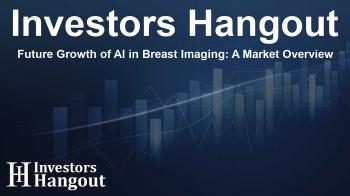Future Growth of AI in Breast Imaging: A Market Overview

The Rise of Artificial Intelligence in Breast Imaging
The global artificial intelligence market in breast imaging is undergoing a transformation, recently projected to reach USD 85,443.3 million by 2033. With a remarkable compound annual growth rate (CAGR) of 30.4%, this market is gaining traction as AI technologies become more integral in healthcare, particularly for breast cancer detection and diagnosis.
This surge is fueled by the alarming increase in breast cancer cases and the urgent need for effective solutions. As technology advances, AI is redefining how radiologists approach breast imaging, enhancing their ability to accurately detect early-stage breast cancer, ultimately saving lives.
Understanding Market Growth Drivers
Several factors contribute to the impressive growth of the artificial intelligence in breast imaging market:
Increasing Incidence of Breast Cancer
With rising rates of breast cancer worldwide, healthcare professionals are under pressure to employ advanced diagnostic tools. AI-driven imaging solutions are pivotal in helping radiologists accurately identify subtle abnormalities, improving early detection capabilities and patient outcomes.
Technological Advancements in AI
The development of sophisticated machine learning algorithms has revolutionized breast imaging. These innovations assist in reducing false positives and negatives, ultimately allowing for a more streamlined and efficient screening process. Technologies like deep learning enhance the precision of mammograms, improving diagnostic accuracy significantly.
Insights into the U.S. Market
The U.S. market for artificial intelligence in breast imaging is thriving, with a projected market value of USD 27,609.0 million by 2033. The demand for early-stage cancer detection is driving this growth, along with the increasing adoption of AI technologies across healthcare facilities.
Regulatory approval for AI-based tools and innovations in imaging platforms continues to strengthen the U.S. market’s position as a leader in adopting these advanced technologies. This momentum indicates a promising future for AI in breast imaging, becoming an essential aspect of diagnostic procedures.
Key Players Shaping the Landscape
Dominating the global artificial intelligence in breast imaging market are major players that include:
- Siemens Healthineers
- GE Healthcare
- Philips Healthcare
- Hologic Inc.
- IBM Watson Health
- Zebra Medical Vision
- iCAD Inc.
These companies are at the forefront of AI-powered imaging technology innovations, striving to enhance diagnostic accuracy and improve healthcare workflows.
Challenges Facing the Market
Despite the rapid growth, the artificial intelligence in breast imaging market faces challenges:
High Implementation Costs
The financial burden of implementing advanced AI solutions can deter smaller healthcare facilities from adopting these technologies. As investment costs remain high, many institutions struggle to justify the expenditure.
Data Privacy Concerns
With AI systems handling sensitive patient information, data privacy and security concerns loom large. Stringent regulations complicate the broader application of AI technologies in healthcare settings, requiring compliance with laws designed to protect patient data.
Future Trends and Opportunities
The potential for growth within the AI in breast imaging is compelling. Some noteworthy trends include:
Personalized Medicine Demand
Patients increasingly expect tailor-made treatment plans. AI’s capability to integrate diverse datasets fosters personalized medicine, allowing practitioners to create individualized care strategies for breast cancer patients.
Expansion in Emerging Markets
As healthcare systems in emerging economies modernize, the adoption of AI technology in breast imaging presents vast opportunities for market expansion. The focus on early cancer detection in these regions aligns with the growth trajectory of AI in breast imaging.
Conclusion
The horizon for artificial intelligence in breast imaging is bright, with expectations for substantial growth in the coming years. Continued advancements in technology and a growing emphasis on preventive healthcare illustrate the pivotal role that AI will play in the future of cancer diagnosis.
Frequently Asked Questions
What is the expected market value for AI in breast imaging by 2033?
The market is projected to reach USD 85,443.3 million by 2033.
What is contributing to the growth of this market?
The rise in breast cancer cases and advancements in AI technology are primary contributing factors.
Who are the major players in the artificial intelligence in breast imaging market?
Key players include Siemens Healthineers, GE Healthcare, and Philips Healthcare.
What are the challenges faced in the market?
High implementation costs and data privacy concerns are significant challenges.
How does AI improve breast cancer detection?
AI enhances the accuracy of imaging techniques, reduces false positives, and supports early diagnosis.
About Investors Hangout
Investors Hangout is a leading online stock forum for financial discussion and learning, offering a wide range of free tools and resources. It draws in traders of all levels, who exchange market knowledge, investigate trading tactics, and keep an eye on industry developments in real time. Featuring financial articles, stock message boards, quotes, charts, company profiles, and live news updates. Through cooperative learning and a wealth of informational resources, it helps users from novices creating their first portfolios to experts honing their techniques. Join Investors Hangout today: https://investorshangout.com/
Disclaimer: The content of this article is solely for general informational purposes only; it does not represent legal, financial, or investment advice. Investors Hangout does not offer financial advice; the author is not a licensed financial advisor. Consult a qualified advisor before making any financial or investment decisions based on this article. The author's interpretation of publicly available data shapes the opinions presented here; as a result, they should not be taken as advice to purchase, sell, or hold any securities mentioned or any other investments. The author does not guarantee the accuracy, completeness, or timeliness of any material, providing it "as is." Information and market conditions may change; past performance is not indicative of future outcomes. If any of the material offered here is inaccurate, please contact us for corrections.
